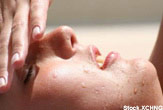What a Headache! Why Modern Life Hurts So Much

If you've ever responded to a work snafu or traffic snarl with the words, "What a headache!" you may have been speaking more literally than you realized. Stressful situations and aching heads go hand-in-hand in our lexicon — and in real life.
Garden-variety headaches and their nastier cousins, migraines, can be triggered by sensory overload and stress, said Merle Diamond, a physician at the Diamond Headache Clinic in Chicago. And although headaches have been around forever, some aspects of modern life may be particularly adept at bringing on these bouts of pain.
"Today, everything's sort of action-packed," Diamond told LiveScience. "Kids are overscheduled, we're overscheduled … I do think non-stop life plays a role."
Multiple triggers
There are dozens of types of headaches, and even more triggers that cause them. Some of these headaches are minor and mostly harmless, like the hangover after a night of bar-hopping or the throb of caffeine withdrawal after cutting back your daily coffee intake. [5 Bad Habits You Should Still Quit ]
Others, like the sudden and severe thunderclap headache, could be a sign of a medical emergency like bleeding around the brain.
More common are migraines, particularly painful headaches accompanied by nausea, vomiting and, sometimes, sensory disturbances called "auras." Migraines have a genetic component, with 70 percent to 80 percent of migraine patients having a family history of the condition.
Sign up for the Live Science daily newsletter now
Get the world’s most fascinating discoveries delivered straight to your inbox.
And then there's the most common ache of all, the tension-type headache. These headaches feel like a tight band or vice is being pressed around the forehead. Most people get them at some point in life, but they're poorly understood because they're rarely serious enough to require medical help.
What doctors do know, Diamond said, is that with both migraines and tension headaches, lifestyle plays a big role.
Staring at screens
Take sensory overload. Modern technology can dose us with head-pounding sights and sounds over unprecedentedly long periods of time. The average American adult spends 8.5 hours a day looking at computer, TV or mobile device screens, according to a 2009 Council for Research Excellence study. Another 2009 survey, this one carried out by U.K. firm npower, found that British children aged 7 to 16 spend 9 hours a day at screen-based activities.
All of this screen time could be bad for the head. A June 2010 study, published in the journal BMC Public Health, found that Nordic teens who spent more time on computers or watching TV had a higher-than-usual risk of getting headaches. The reason, lead author, Torbjoern Torsheim of the University of Bergen told LiveScience, seems to be the strain of holding the body in one position for long periods of time.
Other research has failed to find a screen-headache connection, although a February 2010 study in the journal BMC Neurology implicated loud music as a headache risk factor. But for people who are already prone to migraine, the sensory overload of computer or video games can be a problem, Diamond said.
"We see it a lot in kids, our young adults with migraine, on the Internet, the visual stimulation of video games," she said. "They're actually a trigger for a lot of people."
Head-pounding stress
But perhaps the greatest contributor to the modern headache is stress.
Stress and anxiety can cause headaches directly, perhaps by disrupting brain chemical levels. Stress also leads to behaviors that make headaches more likely, such as poor sleep and skipped meals.
These stress effects can be long-lasting. According to research presented at the American Headache Society's annual meeting in June, negative experiences in early childhood lead to more headaches in adulthood. Emotional abuse is the strongest trigger. Additional childhood stressors, such as parental divorce or drug-addicted family members, raised the risk even more, said Gretchen Tietjen, a neurologist at the University of Toledo College of Medicine and lead researcher of the study. Those with five childhood stressors had twice the risk of adult headache than those without stressors.
"What happens, based on some interesting basic science work in animals, is when people have had a lot of stress early in life, it basically changes the brain," Tietjen said. "And it changes it in ways that probably aren't reversible and, in some cases, become more pronounced as the person ages."
Many of these changes take place in a part of the brain called the hypothalamic-pituitary-adrenal, or HPA, axis, Tietjen said. This axis regulates stress, memory and emotions. Abnormal levels of stress hormones controlled by the HPA axis have been linked to migraines.
Soothing the pain
Whether you're predisposed to headaches or not, treatment is a three-pronged approach, Diamond said. Preventative drugs can halt frequent headaches. Painkillers can be used to ease a headache already in progress. And keeping a headache diary to track symptoms and triggers can make avoiding headaches simpler.
While severe headaches will often require pharmaceutical treatment, sometimes slowing down is all it takes to stop headaches in their tracks, Diamond said. Relaxation and biofeedback techniques that soothe the body have been shown to help migraine and chronic headache patients.
"Making time for just not doing anything is really important," Diamond said.

Stephanie Pappas is a contributing writer for Live Science, covering topics ranging from geoscience to archaeology to the human brain and behavior. She was previously a senior writer for Live Science but is now a freelancer based in Denver, Colorado, and regularly contributes to Scientific American and The Monitor, the monthly magazine of the American Psychological Association. Stephanie received a bachelor's degree in psychology from the University of South Carolina and a graduate certificate in science communication from the University of California, Santa Cruz.
Why is yawning contagious?
Scientific consensus shows race is a human invention, not biological reality









